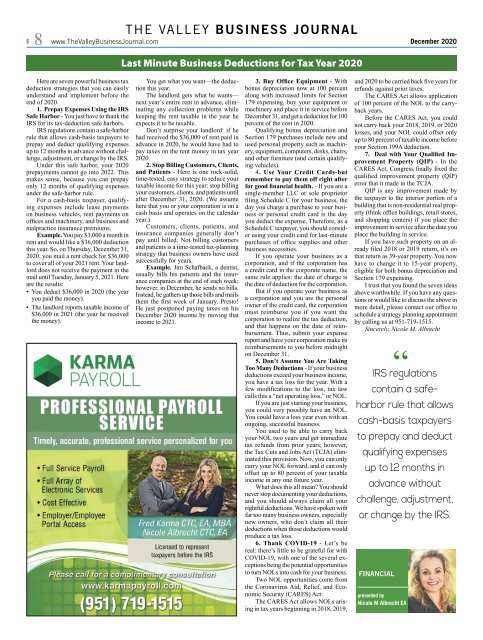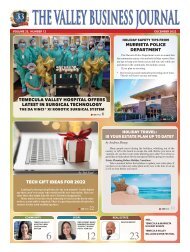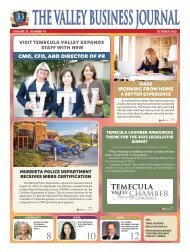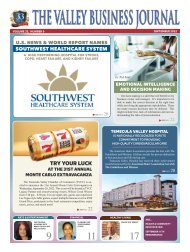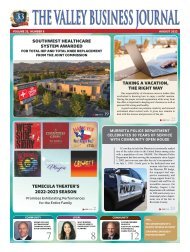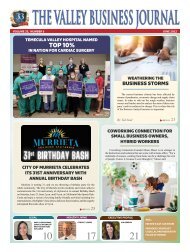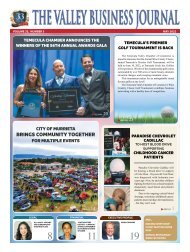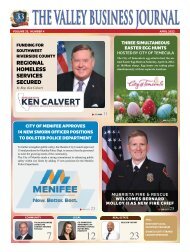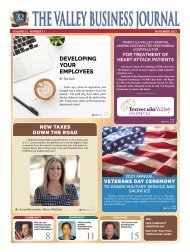December 20
Create successful ePaper yourself
Turn your PDF publications into a flip-book with our unique Google optimized e-Paper software.
THE VALLEY BUSINESS JOURNAL<br />
8 www.TheValleyBusinessJournal.com<br />
<strong>December</strong> <strong>20</strong><strong>20</strong><br />
Last Minute Business Deductions for Tax Year <strong>20</strong><strong>20</strong><br />
Here are seven powerful business tax<br />
deduction strategies that you can easily<br />
understand and implement before the<br />
end of <strong>20</strong><strong>20</strong>.<br />
1. Prepay Expenses Using the IRS<br />
Safe Harbor - You just have to thank the<br />
IRS for its tax-deduction safe harbors.<br />
IRS regulations contain a safe-harbor<br />
rule that allows cash-basis taxpayers to<br />
prepay and deduct qualifying expenses<br />
up to 12 months in advance without challenge,<br />
adjustment, or change by the IRS.<br />
Under this safe harbor, your <strong>20</strong><strong>20</strong><br />
prepayments cannot go into <strong>20</strong>22. This<br />
makes sense, because you can prepay<br />
only 12 months of qualifying expenses<br />
under the safe-harbor rule.<br />
For a cash-basis taxpayer, qualifying<br />
expenses include lease payments<br />
on business vehicles, rent payments on<br />
offices and machinery, and business and<br />
malpractice insurance premiums.<br />
Example. You pay $3,000 a month in<br />
rent and would like a $36,000 deduction<br />
this year. So, on Thursday, <strong>December</strong> 31,<br />
<strong>20</strong><strong>20</strong>, you mail a rent check for $36,000<br />
to cover all of your <strong>20</strong>21 rent. Your landlord<br />
does not receive the payment in the<br />
mail until Tuesday, January 5, <strong>20</strong>21. Here<br />
are the results:<br />
• You deduct $36,000 in <strong>20</strong><strong>20</strong> (the year<br />
you paid the money).<br />
• The landlord reports taxable income of<br />
$36,000 in <strong>20</strong>21 (the year he received<br />
the money).<br />
You get what you want—the deduction<br />
this year.<br />
The landlord gets what he wants—<br />
next year’s entire rent in advance, eliminating<br />
any collection problems while<br />
keeping the rent taxable in the year he<br />
expects it to be taxable.<br />
Don’t surprise your landlord: if he<br />
had received the $36,000 of rent paid in<br />
advance in <strong>20</strong><strong>20</strong>, he would have had to<br />
pay taxes on the rent money in tax year<br />
<strong>20</strong><strong>20</strong>.<br />
2. Stop Billing Customers, Clients,<br />
and Patients - Here is one rock-solid,<br />
time-tested, easy strategy to reduce your<br />
taxable income for this year: stop billing<br />
your customers, clients, and patients until<br />
after <strong>December</strong> 31, <strong>20</strong><strong>20</strong>. (We assume<br />
here that you or your corporation is on a<br />
cash basis and operates on the calendar<br />
year.)<br />
Customers, clients, patients, and<br />
insurance companies generally don’t<br />
pay until billed. Not billing customers<br />
and patients is a time-tested tax-planning<br />
strategy that business owners have used<br />
successfully for years.<br />
Example. Jim Schafback, a dentist,<br />
usually bills his patients and the insurance<br />
companies at the end of each week;<br />
however, in <strong>December</strong>, he sends no bills.<br />
Instead, he gathers up those bills and mails<br />
them the first week of January. Presto!<br />
He just postponed paying taxes on his<br />
<strong>December</strong> <strong>20</strong><strong>20</strong> income by moving that<br />
income to <strong>20</strong>21.<br />
3. Buy Office Equipment - With<br />
bonus depreciation now at 100 percent<br />
along with increased limits for Section<br />
179 expensing, buy your equipment or<br />
machinery and place it in service before<br />
<strong>December</strong> 31, and get a deduction for 100<br />
percent of the cost in <strong>20</strong><strong>20</strong>.<br />
Qualifying bonus depreciation and<br />
Section 179 purchases include new and<br />
used personal property such as machinery,<br />
equipment, computers, desks, chairs,<br />
and other furniture (and certain qualifying<br />
vehicles).<br />
4. Use Your Credit Cards-but<br />
remember to pay them off right after<br />
for good financial health. - If you are a<br />
single-member LLC or sole proprietor<br />
filing Schedule C for your business, the<br />
day you charge a purchase to your business<br />
or personal credit card is the day<br />
you deduct the expense. Therefore, as a<br />
Schedule C taxpayer, you should consider<br />
using your credit card for last-minute<br />
purchases of office supplies and other<br />
business necessities.<br />
If you operate your business as a<br />
corporation, and if the corporation has<br />
a credit card in the corporate name, the<br />
same rule applies: the date of charge is<br />
the date of deduction for the corporation.<br />
But if you operate your business as<br />
a corporation and you are the personal<br />
owner of the credit card, the corporation<br />
must reimburse you if you want the<br />
corporation to realize the tax deduction,<br />
and that happens on the date of reimbursement.<br />
Thus, submit your expense<br />
report and have your corporation make its<br />
reimbursements to you before midnight<br />
on <strong>December</strong> 31.<br />
5. Don’t Assume You Are Taking<br />
Too Many Deductions - If your business<br />
deductions exceed your business income,<br />
you have a tax loss for the year. With a<br />
few modifications to the loss, tax law<br />
calls this a “net operating loss,” or NOL.<br />
If you are just starting your business,<br />
you could very possibly have an NOL.<br />
You could have a loss year even with an<br />
ongoing, successful business.<br />
You used to be able to carry back<br />
your NOL two years and get immediate<br />
tax refunds from prior years; however,<br />
the Tax Cuts and Jobs Act (TCJA) eliminated<br />
this provision. Now, you can only<br />
carry your NOL forward, and it can only<br />
offset up to 80 percent of your taxable<br />
income in any one future year.<br />
What does this all mean? You should<br />
never stop documenting your deductions,<br />
and you should always claim all your<br />
rightful deductions. We have spoken with<br />
far too many business owners, especially<br />
new owners, who don’t claim all their<br />
deductions when those deductions would<br />
produce a tax loss.<br />
6. Thank COVID-19 - Let’s be<br />
real: there’s little to be grateful for with<br />
COVID-19, with one of the several exceptions<br />
being the potential opportunities<br />
to turn NOLs into cash for your business.<br />
Two NOL opportunities come from<br />
the Coronavirus Aid, Relief, and Economic<br />
Security (CARES) Act:<br />
The CARES Act allows NOLs arising<br />
in tax years beginning in <strong>20</strong>18, <strong>20</strong>19,<br />
and <strong>20</strong><strong>20</strong> to be carried back five years for<br />
refunds against prior taxes.<br />
The CARES Act allows application<br />
of 100 percent of the NOL to the carryback<br />
years.<br />
Before the CARES Act, you could<br />
not carry back your <strong>20</strong>18, <strong>20</strong>19, or <strong>20</strong><strong>20</strong><br />
losses, and your NOL could offset only<br />
up to 80 percent of taxable income before<br />
your Section 199A deduction.<br />
7. Deal with Your Qualified Improvement<br />
Property (QIP) - In the<br />
CARES Act, Congress finally fixed the<br />
qualified improvement property (QIP)<br />
error that it made in the TCJA.<br />
QIP is any improvement made by<br />
the taxpayer to the interior portion of a<br />
building that is non-residential real property<br />
(think office buildings, retail stores,<br />
and shopping centers) if you place the<br />
improvement in service after the date you<br />
place the building in service.<br />
If you have such property on an already<br />
filed <strong>20</strong>18 or <strong>20</strong>19 return, it’s on<br />
that return as 39-year property. You now<br />
have to change it to 15-year property,<br />
eligible for both bonus depreciation and<br />
Section 179 expensing.<br />
I trust that you found the seven ideas<br />
above worthwhile. If you have any questions<br />
or would like to discuss the above in<br />
more detail, please contact our office to<br />
schedule a strategy planning appointment<br />
by calling us at 951-719-1515.<br />
Sincerely, Nicole M. Albrecht<br />
“<br />
IRS regulations<br />
contain a safe-<br />
harbor rule that allows<br />
cash-basis taxpayers<br />
to prepay and deduct<br />
qualifying expenses<br />
up to 12 months in<br />
advance without<br />
challenge, adjustment,<br />
or change by the IRS.<br />
FINANCIAL<br />
presented by<br />
Nicole M Albrecht EA


